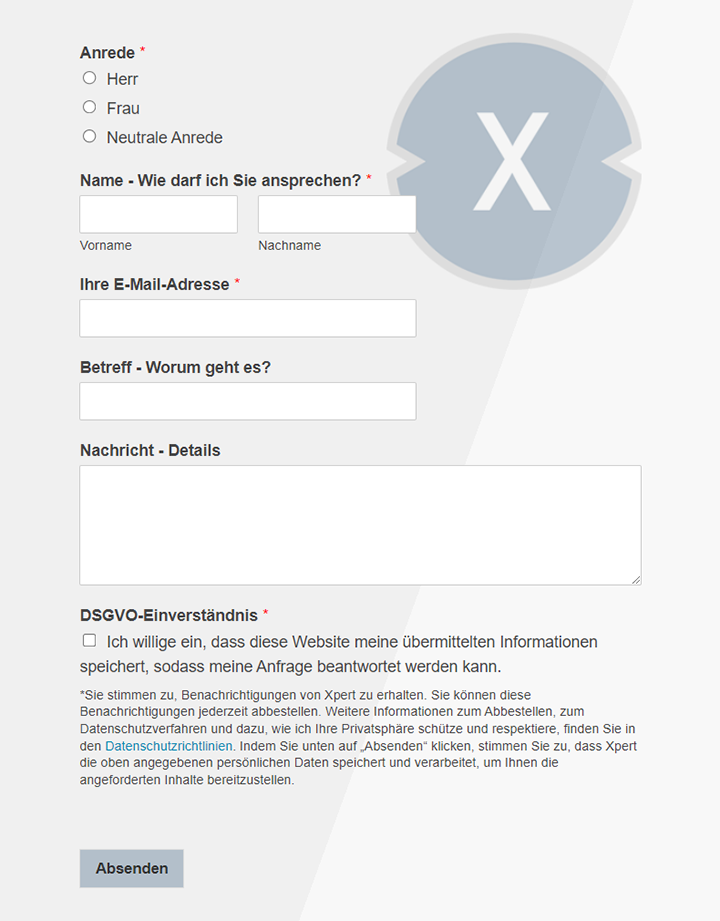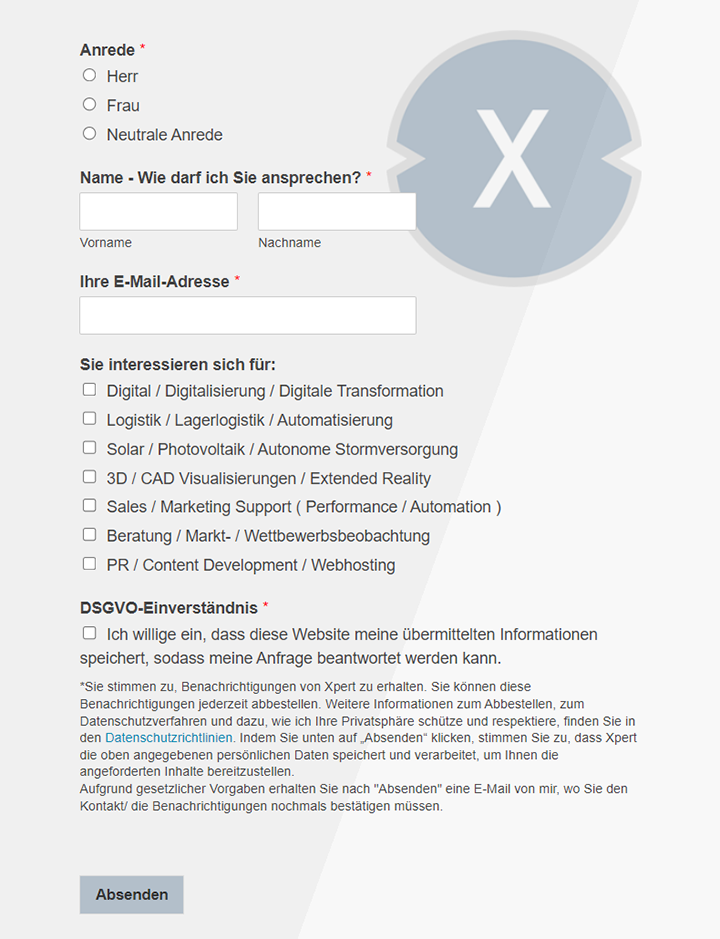Technology disaster for battery storage? Experts raise the alarm due to frequent failures and lack of software
Xpert pre-release
Language selection 📢
Published on: February 14, 2025 / update from: 14th February 2025 - Author: Konrad Wolfenstein

Unveiling survey: These errors bring battery storage to your limits-and cost operators millions-picture: xpert.digital
Battery at the limit? This is how frequent mistakes endanger the future of energy storage - and what needs to be done now
Unveiling survey: These errors bring battery storage to their limits-and operators cost millions
The energy transition and the growing need for stable and flexible power nets have come into focus. These systems play a key role in the integration of renewable energies, the network stabilization and the provision of various energy services. Despite its enormous potential, the BESS industry is still facing considerable challenges in daily operation and management of these complex systems. A current study that “ Bess ProS Survey ” from Twaice has now highlighted these challenges and provides valuable insights into the problem areas and the need for action in the industry.
The BESS industry (BESS = Battery Energy Storage Systems) includes companies and technologies that deal with the storage of electrical energy in battery systems. These storage solutions play a central role in the energy transition because they enable renewable energy sources such as solar and wind energy that are volatile and dependent on the weather efficiently by storing excess energy and feeding back into the power grid if necessary.
The survey in which over 80 industry experts took part, including plant managers, operating and maintenance staff as well as managers as well as managers, draws a clear picture: the operation of battery storage is more complex and more pronounced than often assumed. A central result of the study is confirmation that system performance and availability is the greatest concern of the operators. Over half of the respondents (58%) named this as their primary challenge. This high number underlines the need to further improve the reliability and efficiency of battery stores in order to maximize their economy and their contribution to the energy transition.
Another alarming result of the survey affects the frequency of technical problems. Almost half of all respondents (46%) stated that they were faced with technical difficulties at least once a month. This value even increases when you look at the perspective of the different professional groups within the BESS industry. In the case of plant managers who have a comprehensive responsibility for the smooth operation of the systems, this proportion is 53%. From the perspective of the operational staff, the problem becomes even clearer: 73% of the company and maintenance employees reported regular technical problems. These figures make it clear that technical disorders in BESS operation are not uncommon, but rather represent a recurring and stressful problem that binds significant resources and affects the overall performance of the systems.
The study also shows that the BESS industry has not yet found the optimal “tech stack”, especially in the area of software solutions. Only a little more than half of the respondents (55%) was satisfied with the technologies and tools that they use for the management of their systems. This relatively low satisfaction indicates that many of the currently available software solutions are not yet optimally tailored to the specific needs and challenges of BESS operation. There is a clear need for specialized software solutions that offer more comprehensive analysis functions, improve data integration and reduce the complexity of BES management.
Suitable for:
Dr. Stephan Rohr , founder and co-CEO from Twaice, sums up the need for a holistic data strategy. He emphasizes that the success in the BESS industry is inseparable from handling data. "If you want to be successful, you need a holistic data strategy from the start, you have to think about data from the start, use it in all phases of the project and evaluate it correctly instead of considering it as a pure accessory," says Dr. Rohr . This statement underlines that data is not only a by-product of the BESS operation, but a central asset that must be used strategically to optimize the performance, to recognize problems at an early stage and to maximize the economy of the systems.
Twaice's survey results thus clarify that the BESS industry is at a turning point. The transition from pure safety operation to active monetization of memory systems requires a paradigm shift in dealing with data and technology. BESS operators urgently need access to reliable data and advanced analysis tools to minimize risks, to optimally use market opportunities and to exploit the full performance of their systems.
Detailed analysis of the system performance and availability problems
The “Bess ProS Survey” has illuminated various specific problems in the area of system performance and availability of battery storage. These problems can be divided into different categories and have different causes and effects on BESS operation.
Frequency of technical problems in detail
The high frequency of technical problems already mentioned (46% per month on average, up to 73% for operating and maintenance staff) is a worrying result. It shows that the BESS company in practice is often accompanied by unexpected failures and disorders. These problems can have a variety of causes, from malfunctions of individual components to software errors to external influences such as extreme weather conditions. The high rate of technical difficulties underlines the need for more robust systems, improved surveillance and maintenance as well as more effective error diagnosis and correction.
Cell light weights: a creeping problem with far -reaching consequences
A particularly relevant problem that was not explicitly quantified in the survey, but is generally known in the BESS industry, are cell light weights. Battery storage systems consist of a variety of individual battery cells that are connected in modules and strands. Ideally, all cells should have identical properties in a system and behave evenly in the company. In reality, however, imbalances often occur between the cells that can increase over time.
Cell movement weights can have different causes, including:
- Manufacturing tolerances: Even with high -quality battery cells, there are minor differences in the electrochemical properties.
- Temperature gradients: Different positions within the battery storage system can lead to uneven temperature distributions, which affects the aging of the cells differently.
- Electricity distribution: Uneven electricity distribution in the modules and strands can also lead to different loads and aging of the cells.
- Age effects: With increasing age of the battery, the differences between the cells are increasing due to different aging rates.
The consequences of cell light weights are diverse and negative:
- Energy waste: Uneven invited and unloaded cells lead to an inefficient use of the total capacity of the storage system. Cells with a lower capacity limit the usable total capacity.
- Increased security risks: Cells that are over or under charge are more susceptible to thermal through and other safety-relevant problems. Immersores can jeopardize the stability of the entire system.
- Reduced total capacity and performance: Cellar light weights reduce the usable capacity of the battery storage and can also affect performance, especially at high unloading or loading rates.
- Accelerated aging and shortened lifespan: cells that are more stressed or work in unfavorable operating states, age faster. Cell light weights can thus shorten the lifespan of the entire batteryank and lead to premature replacement of components.
Cooling problems: heat as a killer and security risk
Another central problem area in BESS operation is cooling problems. Batteries generate heat in operation, especially when charging and unloading with high currents. Effective cooling is therefore essential in order to keep the operating temperature of the cells in an optimal area. Overheating can lead to a loss of performance, accelerated aging and, in the worst case, a thermal through, a dangerous event in which the battery can overheat and get on fire.
Cooling problems can have different causes:
- Inadequate dimensioning of the cooling system: In some cases, the cooling system may not be sufficiently dimensioned to pay the heat that arises during operation, especially with high ambient temperatures or intensive use of the storage system.
- Failure of cooling components: mechanical or electrical defects of fans, pumps, heat bodies or other components of the cooling system can lead to a failure of the cooling.
- Constipation or pollution: Cool channels can clog through dust, dirt or corrosion, which affects cooling capacity.
- Inefficient refrigerated strategies: incorrect control of the cooling system or an inefficient arrangement of the cooling components can lead to uneven cooling and hotspots within the battery storage.
The consequences of cooling problems are serious:
- Locating performance: At increased temperatures, the performance of battery cells decreases. The internal resistance increases, which leads to voltage loss and less energy efficiency.
- Security risks: Overheating is an essential risk factor for thermal through. The failure of cooling can drastically increase the likelihood of such an event.
- Accelerated aging: High operating temperatures accelerate the chemical degradation processes in the battery and thus shorten the lifespan.
Data management and integration: The challenge of the flood of information
Twaice survey has also identified difficulties in data management and integration as an important challenge (34% of those surveyed). Modern battery storage systems are highly complex systems that generate a variety of data, including tensions, currents, temperatures, loading states, error codes and much more. The effective recording, evaluation and use of this data is crucial for optimized operation, the error diagnosis and the life forecast from Bess.
Delicate challenges in data management and integration:
- Data volume and variety: The sheer amount of data generated by a BES can be overwhelming. In addition, the data is often available in different formats and from different sources.
- Data quality: Not all data are equivalent. Mass errors, noise or incomplete data can make the analysis more difficult and lead to incorrect conclusions.
- Data integration: BESS data must often be integrated into existing energy management systems (EMS), network control systems or cloud platforms. This integration can be complex and requires standardized interfaces and protocols.
- Data analysis and visualization: Raw data alone are not very meaningful. Advanced analysis tools and visualizations are required to extract relevant information from the data and make usable for BESS operation.
The consequences of inadequate data management and integration are:
- Inefficient operation: Without comprehensive data analysis, it is difficult to optimize BESS operation, adapt charging and discharge strategies or to react to changes on the net or market.
- Delayed error detection: Problems such as cell light weights, cooling problems or the beginning degradation can remain undetected and worsen without effective data monitoring and analysis.
- Restricted life forecast: A precise prediction of the battery life and the maintenance requirement is hardly possible without comprehensive data analysis. This makes long -term planning and profitability calculation difficult.
Degradation and service life management: The ticking clock of the battery
Another important problem area, which was mentioned by 31% of the survey participants, is the degradation and lifespan management of battery storage. Batteries are wearing parts, the capacity and performance of which decrease over time. This degradation process is inevitable, but is influenced by various factors, including operating temperature, loading and unloading cycles, loading status and electricity rates.
Suitable for:
Challenges in the field of degradation and life management include:
- Capacity loss: The usable capacity of the battery decreases over time. This loss of capacity is a natural aging process caused by chemical and physical changes in the battery cells.
- Derivation of performance: In addition to loss of capacity, the performance of the battery, especially with high electricity rates, can also remove over time. This is caused by an increase in the inner resistance of the cells.
- Lifetime forecast: The exact prediction of the battery life is complex and depends on many factors. Manufacturers are often only estimates and can differ in practice.
- Optimization of the lifespan: BESS operators are faced with the challenge of designing the operation of their systems in such a way that the lifespan is maximized without affecting the economy and the fulfillment of the system requirements.
The consequences of inadequate degradation and life management are:
- Shortened useful life: A faster degradation leads to a shorter lifespan of the battery storage and to higher exchanges.
- Economic losses: The loss of capacity and the loss of performance reduce the income from BESS mode because less energy can be saved and provided.
- Uncertainties in long -term planning: Inaccurate life forecast makes long -term planning of maintenance, exchange and investments in new battery storage systems.
Strategies to reduce degradation and extension of the service life
In view of the challenges mentioned, it is of crucial importance to implement strategies and measures that slow down the degradation of battery stores and extend their lifespan. These strategies can be divided into different areas:
Intelligent charging management: gentle charging for long service life
Intelligent charging management is a key factor to reduce battery grade. It is about designing the charging process in such a way that the battery is loaded as little as possible and works in optimal operating states.
Optimal loading status (State of Charge - SoC): It is advisable to keep the charging status of the battery in a moderate area, typically between 20% and 80%. Extreme loading states, both full load (100%) and deep discharge (near 0%), strain the battery and accelerate the degradation. Avoiding this extreme contributes significantly to the extension of the lifespan. This area is often referred to as a “Sweet Spot” for life's optimization.
Avoidance of extremes: The consistent avoidance of full loads and deep discharges is a central aspect of the intelligent charging management. Strategies such as limiting the maximum state of charge and the determination of a discharge depth limit can be implemented in order to avoid this extreme.
Reduced loading speed: quick charging, especially at high loading states, the battery can strain more than slow charging. Loading with alternating current (AC shop) is usually gentler than quick charging with DC (DC shop). For applications in which the loading time is not critical, a reduced charging speed can have a positive impact on the lifespan. Modern charging systems often offer the option of regulating the charging speed and adapting to the respective needs.
Temperature management: cool heads for long service life
As already mentioned, the operating temperature is a decisive factor for battery battery. Effective temperature management is therefore essential to keep the battery in an optimal temperature range.
Optimal temperature range: The ideal temperature range for lithium-ion batteries is typically between 15 ° C and 35 ° C. Consulting this area minimizes the degradation rate and maximizes the service life.
Avoidance of extreme temperatures: Both very high and very low temperatures are harmful to batteries. Loading at temperatures below 10 ° C should be avoided, as this can lead to lithium plating and loss of capacity. Storage at temperatures above 40 ° C also accelerates the degradation.
Active cooling: In many BESS applications, active cooling is required to regulate the operating temperature of the batteries, especially with high performance requirements or in warm climates. Various cooling technologies are available, including air cooling, liquid cooling and phase change materials. The choice of suitable cooling technology depends on the specific requirements of the application and environmental conditions.
Optimization of use: gentle operating strategies for maximum lifespan
The way a battery storage system is used has a significant impact on its lifespan. An optimized usage strategy can minimize the degradation and extend the service life.
Limitation of the discharge depth (Depth of Discharge - Dod): Frequent deep discharges burden the battery more than flat discharges. Limiting the depth of discharge, for example to 80% dod, can significantly increase the number of life cycles. Manufacturers often provide recommendations for the maximum discharge depth for their batteries.
Reduction of high -stream loads: high power loads, both when loading and unloading, lead to stronger heating of the battery and an increased load on the cells. Limiting high -stream loads can reduce the degradation and extend the lifespan. In many applications, it is possible to adapt the operating strategy so that load tips are covered by the battery memory, while the base load operation takes place with lower power rates.
Cycling management: The number of loading and unloading cycles is an important factor for the battery life. Limiting the daily charging cycles, for example by intelligent control of the storage insert, can extend the lifespan. In some applications it is possible to use the memory primarily for certain time windows or events and to reduce the number of cycles per day.
Advanced technologies and software solutions: intelligence for long service life
Modern technologies and software solutions play a crucial role in optimizing BESS operation and the life of life.
Battery management systems (BMS): Modern BMS are highly developed control systems that monitor and optimize the condition of the battery in real time. They capture a variety of parameters such as cell voltages, cell temperatures, currents and loading states. Based on this data, you can control the loading and discharge process, compensate for cell light weights, regulate the cooling and identify fault states. Advanced BMS have algorithms to the life forecast and adaptive adaptation of the operating strategy to the battery state.
Analytics platforms: Cloud-based analytics platforms enable the central recording and evaluation of BES data from various systems. They offer real -time monitoring, trend analyzes, error diagnosis and predictive maintenance functions. By using big data analytics and artificial intelligence, these platforms can provide valuable insights into the battery state and performance and contribute to optimizing the operation and service life.
Regular software updates: The software of inverters, energy management systems and BMS is continuously developed and improved. Regular software updates ensure that the systems work with the latest algorithms and functions and are optimally tailored to the current requirements and findings.
Maintenance and care: regular checks for permanent performance
In addition to the technological measures, regular maintenance and care are essential for the long -term performance and service life of battery storage.
Regular checks: Routine inspections should be carried out to identify wear, damage or anomalies at an early stage. This includes checking connections, cables, cooling components, housings and the measurement of cell stresses and temperatures.
Clean environment: A clean and dry location is important to avoid corrosion and pollution. The battery should be cleaned regularly to remove dust and dirt. Suitable tools and cleaning agents should be used to avoid damage.
Innovative approaches: beyond the standard company
In addition to the established strategies, there are also innovative approaches that could play an even greater role in the life of the life of battery stores in the future.
Cyclization in the optimal area (“Radical Aging Optimizer”): Some studies indicate that cycling in a very narrow loading state area, for example between 15% and 50% SOC, can significantly extend the lifespan of batteries in certain applications. This strategy, which is referred to as “Radical Aging Optimizer”, aims to primarily operate the battery in the area in which the degradation rate is the lowest.
Capacity expansion: In some cases, it can make economic sense to expand the overall capacity of the battery storage system physically or virtually over time. This can be done by replacing individual modules or by integrating additional storage capacity. A virtual capacity expansion can be achieved by intelligent control of the memory insert, for example by reducing the discharge depth and adapting the usable capacity to the current need.
Guarantee and contract management: protection and long-term economy
The guarantee and contract management are of central importance for the economic success and long -term protection of battery storage systems. Battery stores are long -term investments and comprehensive guarantees are essential to minimize the investment risk.
Meaning of the guarantee: long -term security for investments
A comprehensive guarantee for battery storage systems offers various forms of protection:
- Long -term protection: Battery storage is usually designed for a lifespan of 10 years or more. A guarantee that covers this period offers long -term security for investing. Warranty periods of 10 years are common in the BESS industry, in some cases even longer warranty times are offered.
- Performance guarantee: A performance guarantee ensures that the battery retains a certain minimum capacity over a certain period of time. This guarantee is crucial for the economy of the system because it ensures that the expected performance over the lifespan is performed. Typically, manufacturers guarantee capacity maintenance of 70% or 80% according to a certain number of years or cycles.
- Product guarantee: A product guarantee covers material defects and factory errors. It protects against early failures due to production defects and ensures the right to repair or exchange defective components.
Contract management and guarantee conditions: The devil is in detail
- Guarantee conditions for battery storage systems are often complex and individual. Careful contract management is therefore essential to keep an overview and ensure that guarantee claims can be asserted if necessary.
- Complexity of the conditions: guarantee contracts for Bess can be extensive and detailed. They often contain specific conditions and clauses that have to be carefully checked and understood. It is advisable to obtain legal advice at the contract examination to ensure that the conditions are appropriate and understandable.
- Compliance with operating limits: guarantees are usually linked to compliance with certain operating limits. These can refer to temperature, state of loading, electricity rates or other operating parameters. Continuous monitoring of the operating data is therefore necessary to ensure that the guarantee conditions are observed.
- Documentation: A precise documentation of operating data, maintenance work and malfunctions is often a prerequisite for the assertion of warranty claims. It is important to systematically record and archive all relevant data in order to be able to provide evidence if necessary.
Effects on the operation: guarantee conditions as a guide
The guarantee conditions have a direct impact on the operating strategy and the maintenance planning of battery storage systems.
- Optimizing the operating strategy: The guarantee conditions often specify in which operating areas the system may move so as not to endanger the guarantee. The operating strategy must therefore be optimized in such a way that it both meets the system requirements and complies with the guarantee conditions. This can mean, for example, to limit the charging state area or to avoid high -voltage loads.
- Maintenance planning: Regular maintenance and inspections are often a prerequisite for receiving the guarantee. The maintenance planning must therefore be designed in such a way that the required maintenance intervals and measures are observed. This can include the implementation of visual tests, the measurement of cell parameters or the exchange of wear parts.
Financial aspects: cost savings and planning security
Effective guarantee and contract management has a significant financial impact on BESS operation.
Cost savings: A valid guarantee can save considerable costs for repairs or the exchange of components. In the event of a defect or an unexpected failure, the costs for repair or exchange can be covered by the guarantee.
Planning security: Clear guarantee conditions enable better financial planning over the lifespan of the system. By knowing the guarantee conditions, operators can better estimate long -term operating costs and minimize financial risks.
Technological support: software for guarantee management
Modern technologies and software solutions can also offer valuable support in the area of guarantee and contract management.
Monitoring tools: Special software tools can automate the monitoring of guarantee conditions and operating parameters. These tools can monitor compliance with operating limits, pursue maintenance intervals and issue warning messages if necessary.
Predictive maintenance: Analytics platforms and predictive maintenance systems can recognize potential problems at an early stage and help to secure warranty claims. By analyzing operating data, these systems can recognize anomalies and the beginning defects before they lead to failure. This enables timely maintenance measures and can underpin guarantee claims.
Holistic approach for successful BESS operation
The “Bess ProS Survey” by Twaice has made it clear that the operation of battery storage systems is associated with considerable challenges. Technical problems, cell light weights, cooling problems, data management and degradation are just a few of the areas in which there is a need for optimization. In order to cope with these challenges and exploit the full performance of battery storage, a holistic approach is required, which includes technological innovations, optimized operating strategies, careful maintenance management and effective guarantee and contract management. Only through the consistent implementation of these measures can the BESS industry develop their full potential and make a significant contribution to the energy transition. The future of energy storage significantly depends on how successful it is to continuously improve the reliability, efficiency and lifespan of battery storage systems.
Plan your solar system for the most common applications conveniently online with our solar system planner!
With our user-friendly solar system planner you can plan your individual solar system online. Whether you need a solar system for your home, your business or for agricultural purposes, our planner offers you the opportunity to take your specific requirements into account and develop a tailor-made solution.
The planning process is simple and intuitive. You simply enter relevant information. Our planner takes this information into account and creates a tailor-made solar system that meets your needs. You can try out different options and configurations to find the optimal solar system for your application.
Additionally, you can save your plan to review later or share with others. Our customer service team is also available to answer your questions and provide support to ensure your solar system is optimally planned.
Use our solar system planner to plan your individual solar system for the most common applications and advance the transition to clean energy. Start now and take an important step towards sustainability and energy independence!

The solar system planner for the most common applications: Plan the solar system online here - Image: Xpert.Digital
More about it here:
We are there for you - advice - planning - implementation - project management
☑️ SME support in strategy, consulting, planning and implementation
☑️ Creation or realignment of the digital strategy and digitalization
☑️ Expansion and optimization of international sales processes
☑️ Global & Digital B2B trading platforms
☑️ Pioneer Business Development
I would be happy to serve as your personal advisor.
You can contact me by filling out the contact form below or simply call me on +49 89 89 674 804 (Munich) .
I'm looking forward to our joint project.
Xpert.Digital - Konrad Wolfenstein
Xpert.Digital is a hub for industry with a focus on digitalization, mechanical engineering, logistics/intralogistics and photovoltaics.
With our 360° business development solution, we support well-known companies from new business to after sales.
Market intelligence, smarketing, marketing automation, content development, PR, mail campaigns, personalized social media and lead nurturing are part of our digital tools.
You can find out more at: www.xpert.digital - www.xpert.solar - www.xpert.plus






















